| |
Don’s Four Star 40
From: Donald Skiff donskiff@mediaone.net
Photos by Warren Plohr
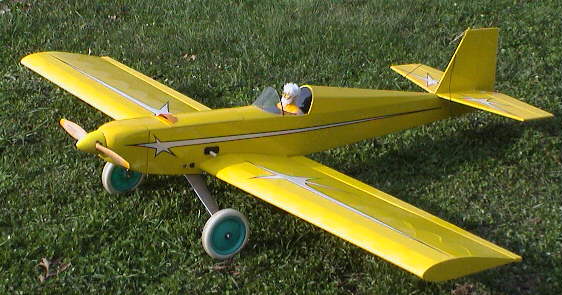
"Thanks, Warren--great pictures! Now I know why the pilots of open-cockpit
planes always wore helmets." Don
Ken, the Four-Star flew great (under Keith's thumbs). After decreasing the amount
of elevator throw and moving the CG forward just a tad, he took it up again and handed it to me. I concentrated on straight and
level flying, and didn't do anything stupid (or "unfortunate," for the less judgmental). It handles nicely. I think it's about
6 pounds all up, but I'll weigh it later. Plenty of oomph, lifts off in 20 feet. The prop is 11-9 Windsor Electric, 16 x 1900SCR cells,
Astro Flight 25G. The big stroller wheels work well on a bumpy field. Otherwise, it's the stock SIG kit.
It's my first aileron plane, so I can't be a good judge, but I give it ****. Now, if I
can only make it last to Mid-America!
(The pilot in the photo IS Don Skiff, just reduced in size to fit in his plane.
Nice job Don! km)
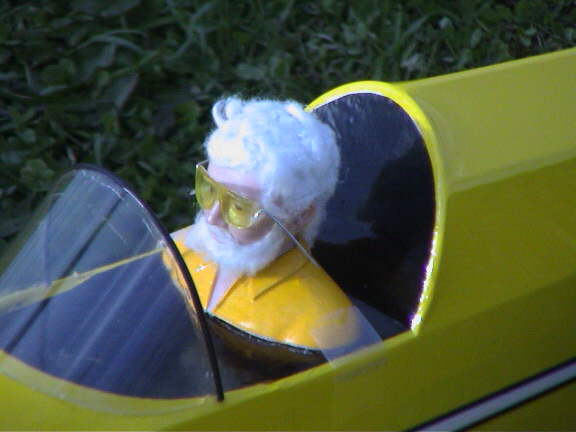 Return to "What's In This Issue?"
Return to "What's In This Issue?"
New! MotoCalc Version 6
From: Stefan Vorkoetter stefan@capable.on.ca
Via the Eflight Mailing List
(My recommendations too hard to follow? This just might be what you need! KM)
Moorefield, May 8, 2001:
Capable Computing, Inc. of Moorefield Ontario has released MotoCalc 6, the latest
version of its electric flight performance prediction program for Microsoft Windows 95, 98, ME, NT, and 2000. MotoCalc 6 is the
first e-flight software package with MotoWizard(tm) and MotOpinion(tm), two features that make it easy for even the complete
beginner to choose the best power system for his or her electric airplane. MotoWizard asks the user a few simple questions
about the model and the user's preferences, and produces a list of suggested power setups. MotOpinion takes the
thorough analysis that MotoCalc is known for, and produces a plain-English report describing the model's and power system's
performance, along with any potential problems. MotoCalc 6 is also the first electric flight prediction program to take the effects
of motor heating into account, resulting in much more accurate predictions, especially when pushing motors to their limits.
MotoCalc 6 is Internet ready, with the ability to save all of its reports as HTML, and graphs as JPEG files. Project cut-and-paste
makes it easy to share MotoCalc projects with friends by e-mail. And, with the new one button update feature, users can keep up
to date, automatically downloading the latest available data from www.motocalc.com.
Other new features include:
- Improved accuracy of propeller and fan thrust, pitch speed, and in-flight unloading calculations.
- Airfoils by name, making it unnecessary to take detailed measurements.
- Flying field air temperature, for more accurate aerodynamics.
In addition to all these new features, MotoCalc 6 continues to provide
the most comprehensive facilities for electric flight performance prediction, including:
- Predicts Volts, Amps, input and output Watts, efficiency, temperature, Watts/lb, RPM, thrust, pitch speed, and run time.
- Tests entire ranges of cells, props, and gear ratios to analyze hundreds of possible combinations in just a few seconds.
- Filters out undesirable combinations by any combination of current limit, power loss, efficiency, thrust, pitch speed, or run-time.
- Sorts report tables by any parameter, in forward or reverse order, to find the best set-up quickly.
- In-flight analysis predicts performance over the entire flight speed range, at any throttle setting.
- Computes level flight time, and climb and sink rates (great for sailplanes) at any throttle setting.
- Graphs any one or two parameters against any other.
- Very easy to use, with extensive motor, cell, drive system, speed control, airframe, and filter databases.
- Lets you add your own components at any time. - Supports multi-bladed props and multi-motors (series, parallel, multiple motors per prop, or multiple props per motor).
- Provides a motor designer to predict the effect of different motor windings.
- Visual lift and drag coefficient estimator lets you easily determine the aerodynamic information needed to accurately predict flight characteristics.
- Selectable English or Metric measurement units.
- Comprehensive on-line manual, with context-sensitive help. MotoCalc 6 is available for download for a 30-day free try-before-you-buy evaluation from our web site, http://www.motocalc.com.
MotoCalc on disk is available for US $35 plus shipping and handling. Downloaded
upgrades are free for registered users, or available on disk for US $10, shipping and handling included. MotoCalc is also available
from East Coast Model Center in Canada, New Creations R/C in the U.S., and Gordon Tarling in the U.K. and Europe.
Special Note:
Stefan posted MotoCalc 6.01 on the web site
www.motocalc.com. The main difference between this and 6.00 is that it will give you
a 30-day evaluation even if an older version of MotoCalc has already expired on your machine.
Return to "What's In This Issue?"
The Saga of the B-17 Continues
From: Bob Mugge EggumBob@aol.com

Ken:
I did some ground and range testing on my B-17 yesterday. It has a range
problem. Since I already have schottky diodes and 3 caps on all 4 motors, I guess I'll try some shielding around the receiver
next. All I get with transmitter antenna collapsed is about 90 feet before things start getting twitchy. The receiver antenna is outside the airplane and there is no servo wiring adjacent to the power circuits. I do have push-pull wires on the tailwheel steering. Covering is aluminum Monokote.
Any ideas?
(I sent him a couple and then received this reply. KM)
Ken:
Have made some changes to the B-17.
1) Checked the relative antenna down ranges of all three receivers and two transmitters that I have on channel 18. No
difference I could measure, so I ruled out a detuning problem.
2) Wrapped the receiver with aluminum foil.
3) Turned the receiver around in the plane so antenna comes out to the rear and all servos plug into the front. This extended
the antenna out beyond the tail more. Now only 3" of the antenna is inside the fuselage. Comes directly out and goes straight to
the top of fin, with remainder of about 10" hanging loose to extend back when in flight. Entire plane is covered in aluminum
Monokote with black Monokote trim. Elevator and rudder pushrods are dowel rod for most of their lengths.
4) Was advised to put ferrite chokes in the throttle servo leads. Purchased some at Radio Shack and installed on not only
throttle but also on flap and aileron servos.
5) Tried another range check today with the plane mounted in PVC cradle on my folding flight table. Got at least 150 feet
antenna down at 0, 1/2, and full throttle without any flutter. The first channel to flutter was throttle. Removed 2 turns of the 3
turns of the throttle wires I had in the ferrite choke. Appeared even better, but then I ran out of motor battery, so couldn't tell for
sure. Looks promising.
I have not tried 6V receiver battery yet--gotta get one. Present receiver battery is a
4.8V NiMH and is mounted on top of receiver sponge wrap. Don't have any servo leads longer than the ones that come with
servos, and most of them are real short and folded back on themselves and cable tied.
I'll keep you informed.
Even More Persistant Radio Problems
I'm still having radio range troubles with the B-17. All the work I did before
(repositioning, adding chokes and foil wrap) eliminated the glitches in the control surface responses. They are now solid at 60
paces (180 feet) per instructions from Futaba, but now I have intermittent throttle circuit response at distances over 20 paces,
which is only about one third of the distance that I need.
I have tried putting the throttle channel on a different receiver and leaving all control
surface channels on the normal receiver, both with the control channel receiver turned off and on. The results are the same. In
fact, it is slightly worse with the control channel receiver turned off. I've also tried another transmitter. Same results. Also
switched the filter chokes (had two different types) between throttle channel and flap and aileron. No change. But problem is
worse if I remove the choke from the throttle channel.
May try to find a scope to check out the signals. Am greatly confused about why
the opto-isolated channel is the only one having the problem. I also may try the Jomar multi-channel isolator, but don't have one
yet.
Any other ideas?
(Anyone have any suggestions we‘ve not tried yet? KM)
Return to "What's In This Issue?"
Canadian Hello
From: Doug Burt flyinace@direct.ca
Ken,
I have read your newsletter for what seems like ages. (To me too! KM) The
"Ampeer" with its various luminaries and guru's in the electric flight field, stories about these individuals and all the
helpful hints. This is what helped to bring me over to Electric Flight in the first place, my natural curiosity is what's kept me here
since. Now I find myself in a place I never thought I would see myself or an event that I put together, namely the "Ampeer".
At this point I would like to say hello and introduce myself. My name is Doug Burt
and I'm the current Electric Committee Chairman for MAAC in Canada. I don't know how come I rose so quickly on the
Canadian E-flight scene, but following last years inaugural Electric Scale events at the Canadian Nationals (which my club
hosted, the North Shore Electric Sport Flyers) it seems as though I've been on a roller coaster ride right to the top. To see the
Pacific e Scale event mentioned in the "Ampeer" was a mind blower for me. Thank you very much for including it. If you have
any requests regarding Canadian e-flyers or e-flight in general in Canada please don't hesitate to contact me directly I'll be glad to
do whatever I can to bring our great sport to even more prominence where possible, although with the likes of Martin Irvine and
Robert Pike involved I know we've got a good team already. Thanks again very much.
Regards,
Doug Burt
Electrics
www.canadianelectricflight.com
Return to "What's In This Issue?"
Book on CL scale and Electronics is ready!
From: Fred Cronenwett clscale@gateway.net
Greetings everyone,
I have finally finished my new book on CL scale and electronic controls. This book
is volume #1 and I hope to continue this series with additional topics. One special note, this book does not show how to build a
model airplane, but how to set the airplane for CL scale or sport flying with electronic controls, fly in competition and
documentation. Everything from the flying lines to electronic controls are discussed. There are several new systems out on the
market that are not included in this book. Bill Young has a new 3 channel handle that he just sent me a example for testing so I
can include this in the next volume. If there are any other systems that should be considered I would need to get photographs of
the system and enough details to write a chapter. Bill was kind enough to let me borrow a 3-channel handle to do just this. I will
be at the NW Regionals in Roseburg, Oregon during the Memorial day weekend with copies of the book for sale. Thanks again
for your support and pass the word around.
This is the first known publication that also documents how to fly with electric
powered CL scale models with proportional throttle control. Yes you can fly an CL model with electric power and have full
throttle control. Grant Hiestand wrote this chapter for the book.
I would like to thank the following people for their input: Bill Young, Grant
Hiestand, Steve Davis, Lynn Boss, Merle Mohring, Bob Banka, Ken Long and my lovely wife Kimberly Kingman.
This book is dedicated to Luciano Nustrini who inspired me to build and fly model
airplanes at the age of 12.
Announcing an exciting new book.
Control Line Scale Modeling
By: Fred Cronenwett
This comprehensive guide on Control Line Scale model airplanes takes the modeler
through all phases required to pick models for CL scale, install electronic controls, assemble documentation, fly and enter scale
competition. The book is softbound; spans 133 pages, has 96 photographs and includes 16 illustrations as well as a fifteen page
photo gallery. Written for the beginner or the experienced modeler this book will save you time and money. Fred Cronenwett has
over 10 years of experience with CL scale model airplanes, scale competition and electronic controls.
Topics include:
Flying Line Construction
Single Channel Electronic Controls
Multi-Channel Electronic Controls
Direct Servo Connection Electronic Controls
The Bill Young Electronic handle (5-channel system)
Electric Power for Control Line Scale & Sport
Trouble Shooting Electronic Controls
Operation at the flying site
Installation ideas for Profile Scale
Converting R/C kits to CL scale
Picking models for CL scale
CL Scale model - stabilizer & wing incidence
Trimming the CL scale model
The Control Line ARF
Throttle Control & Test flying
Multi-Engine CL models
CL Scale Competition
Flaps and Retractable landing gear
CL Scale Documentation
Documenting the color of your aircraft
How to pick 3-views
Control Line Scale contacts
How to order:
The cost is $24.95 US Dollars each
California residents add 8% sales tax ($26.95 plus shipping, see below)
United States, Hawaii, Alaska: $4
Canada and Mexico: $8
International orders: $10
Please send check or money order payable to Fred Cronenwett:
Fred Cronenwett
18375 Ventura Blvd, #173
Tarzana, CA 91356
Return to "What's In This Issue?"
Sig LT-25
From: Tex Gehman eliztex@home.com
Ken,
I follow your pages regularly, and I think I have something to contribute to your
ratings of E-models. I have not seen my particular setup so here go's:
*****
Sig LT-25
Astro Flight 035/Superbox gears
8xRC2000 cells
Castle Creations Pegasis controller using BEC
APC 12x8E and APC 12x10E
Weight ready to fly with 8xRC2000: 70 oz!
Three micro servos: Fut S33(rud) HiTech 81BB(ail) HiTech 85BBMG(elev)
Those are the tech specs. My only modifications to the kit were to make the nose
more like a PT- 19 to reduce drag and to sharpen the LE's of all the tail feathers. I modified the front section forward of the
wing to accept bigger hatch an made the wing bolt-on. Oh yes, I did my own thing to steer the tailwheel, rather than their pull-
pull system.
Original flights were with a APC 12x8E. It drew 180 watts (19A) and ROG'd well
from a grass field. 10-11 minutes of training were easy, including touch and go's. I later fitted a 12x10E and was able to notice a
difference in performance. Now it is 240W and 29A which is in the realm of Astro Bob's recommendations.
This configuration weighs much less than others on this sheet, and is able to use the
BEC function which I feel is important to new flyers and to those of us who use the plane for continuous training and for winter
flying.
And I must say it was a pleasure to assemble, (the word "build" really
does not apply).
Questions to Tex at eliztex@home.com
Keep up the good work, Tex Gehman (Sabrejock)
Return to "What's In This Issue?"
Aqua Star Seaplane Rating & Review
From: Stefan Paneczko Kx13272@aol.com
Star Rating: ***1/2
Aircraft Name: Aqua-Star sea plane
Aircraft Manufacturer: Herr Engineering
Laser cut kit
Type of aircraft: Sport
Wing span: 44 1/4"
Wing area: 265.5"
Wing Loading: 14.1 oz./sq.ft.
Power System: 175 watts at 15.4 amps!!
Motor:
Manufacturer: Graupner Speed 400
Weight: 2.9 oz. (including prop & adapter)
Source: New Creations
Battery: N-800AR
Manufacturer: Sanyo
mAh Rating: 800 mAh
Number of cells: 8
Connectors: Anderson Power Pole's
Source: battery from Hobby Lobby - connectors bought on e-bay
Electronic Speed Controller
Manufacturer: Aveox
Model number: A-15
Maximum number of cells: 16
Maximum amp rating: 20
BEC: Yes
Brake: Yes
Source(s) local hobby shop
Gearing - if used: none
Prop
Manufacturer:Aeronaut Glas Elektro
Type: white, nylon/fiberglass Elliptical blades
Size: 6x5
Source: New Creations
R/C Components
Receiver
Manufacturer: Hitec Feather
Model number: #RCD20272
Weight: 0.2 oz.
Number of channels: 4
Number of channels used: 3
Source: local hobby shop
Servos:
Manufacturer: Hitec
Model number: HS-81
Weight: 0.59 oz
Number of servos used: 2
Source: local hobby shop
Receiver battery - if used: none
Finished Aircraft weight: (including R/C components and power system including flight battery.) 26 oz.
Comments on construction and flying: First let me say that the Herr
Engineering kit and the laser cutting are AWESOME!!!! For the money you can't go wrong. Second, I built the plane using all
the modifications done by Nick Ziroli Sr. He built and wrote a review of this plane in Flying Models magazine (March 2001).
Third, this plane needs shear webbing between the balsa spars. (I'm doing 2/3 of the wing) I lost the right side wing at 200 feet.
The wing made a 90 degree angle when it broke. I also lost the front half of the fuselage. The wing is fixable and the back half
of the fuselage, including the tail group is perfect!
The building of this plane is EASY!! I would recommend this to anybody who has
the ability to glue two piece of wood together, but you need to sand the tops of some pieces like the wing ribs. The discoloration
from the laser bleeds through the covering. I used Ultracoat/Oracover to do this plane.
Upon the first test flight I found it FAST!! I set the controls to exactly what the
plans said. I recommend that you keep the rudder movement easy. Too fast on it and the wing tips right down. Also, put in down
thrust - at least 3 degrees.
For the beginner, have an experienced pilot take it up for you until you get a hang
of the flying characteristics of this plane.
No, I didn't get a chance to try it off the water. I hand launched mine. The plans
have an upgrade that shows how to make and extend the chine rails for better R.O.W.
One last thing, I couldn't get the clear windshield to work. I think the only thing
they need to do is make a vacuum formed one. Yes, the kit can be built stock and fly well. You can e-mail me or check the
E-zone for information on this plane. There's plenty of info on it. Good luck.
Return to "What's In This Issue?"
Electwin
From: Dale Martell email: dbmartell@earthlink.net
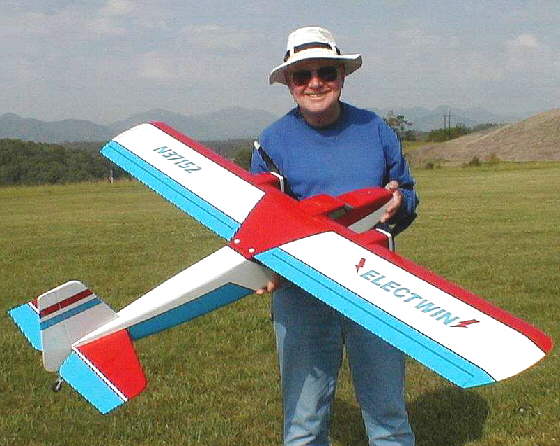
Hi Ken,
I thought you might like to see a couple of photos of my latest project. This is the
plane that I have written you about for advice. I appreciate your help with it.
It is a twin, using two Astro .05 geared motors driving Master Airscrew 12x8
electric nylon props. I am using 14 cells and an Astro ESC. It is my own design that I drew up on a ModelCad program. It
weighs 5 1/2 lb. And develops 3 1/2 lb. of thrust. It flies well off of our grass field and does standard aerobatics easily. The
wingspan is 67 inches with 650 square inches.
Thanks again for your help.
Dale Martell
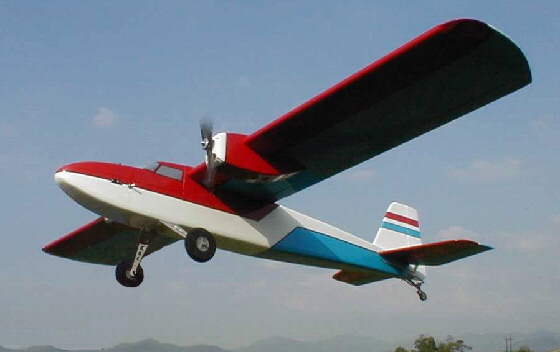 Return to "What's In This Issue?"
Return to "What's In This Issue?"
ElectricAircraft.com
Via May DEAF Notes
Editor: Greg Judy
Jim Bourke asked me to pass on this information about a new Online Hobby Buyers Club that he’s started.
"ElectricAircraft.com is not a distributor, a retailer, or a manufacturer. We
are a hobby buyer’s club with no monthly fee. Vendors list their products for sale in one central location. Our visitors browse
the product listings, leave ratings and reviews, add products to their shopping carts, and purchase whatever they need. When you
place an order, the order is automatically routed to the individual vendors for shipping."
Here are the categories that Jim has at this time:
Aircraft - Accessories, Blimps, Helicopters, Jets, Scale, Slowflyer, Sport
Electronics - Chargers, Speed Controls, Radios, Servos
Power - Batteries, Connectors & Wire, Fan Units, Gearboxes, Motors
Media - Books, Videos, Artwork
Return to "What's In This Issue?"
News from RCB Kits
From: Rob Bulk info@rbckits.com
Hello friends,
We have updated our site with some new pictures at the "news" section, including some Action shots of the Skyhawk and Beaufighter. Also there are pictures of the new Pou du Ciel HM16 which will be a kit in a few months.
The Panther is on hold as we redesigning the aeroplane for faster flying. We are building the prototype now. The Cutlass will not change much, we just need time for this one. Expected in the future is the Horten 9, for twin mini fan.
Good luck and health to everybody.
Greetings and happy flying
R.Bulk RBCkits
Tel 0031(0)172-231869
Fax 0031(0)172-231866
Web: www.rbckits.com
Return to "What's In This Issue?"
Fiesler Storch Identified
From: Brian Chan bhchan@mail.arc.nasa.gov
Ken,
I am the unknown builder of the Fiesler Storch in the April Ampeer. It is the
same one in the Kit Review in the S&E Modeler, imported by Hobby Club.
Regards,
Brian Chan
An Electric Airplane Junkie@San Mateo.Ca.USA
(You‘ll find the review on page 87 of the March 2001, S&E Modeler. KM)
Return to "What's In This Issue?"
Another LT-25
From: Ken Marks Louisville, KY email: KenA.Marks@mail.state.ky.us
Ken,
I finished my SIG LT-25 this past weekend, and it flew great. It impressed many of
the old timers. I am using the Astro 625G (straight gearing), 12x8 wood prop, 2- 7 cell 1900 mAh Sanyo battery packs and a
Astro 217D ESC. The plane has a flying weight of 5 1/4 lbs. Flights were lasting a little over 6 minutes. The plane will ROG
quickly from a paved runway. The plane will do loops with ease. Thanks for the great information and I hope to convert a few
fellow club members to electric.
Return to "What's In This Issue?"
Me 163
From: Craig Oakeshott Oakeshott.Craig@saugov.sa.gov.au
Ken,
Some months ago I contacted you about putting together a scratch built ME 163. A
few kind people got back to me but unfortunately I couldn't find any reasonable electric plans. So I made my own! then after a
great deal of mucking about, the tragic demise of the first prototype a considerable amount of redesign and the construction of a
new version....Success!!!.

The initially drive train was a speed 480 BB race with a 5x5 prop on 8 500AR's.
All up weight was about 24 oz, without a watt meter I had no idea how much current it was drawing but I was only getting about
45 seconds of powered flight out of it and very hot batteries afterwards. So with a wing area of about 220 square inches I was
up at around 18-19 oz/sq.ft. and by the run time of the motor about 150w/lb. No wonder it was ballistic in terms of climb.
So I went up to a 8x1200SCRL pack increasing the weight to about 30 oz. and
then I managed to test the current draw at almost 30 amps on the same drive train. The problem then was that I couldn't get a
full discharge out of the pack because it was drawing so much the voltage would drop too quickly and the BEC would cut in after
about 1 and a half minutes. Flying at half throttle I could get almost 6 minutes out of it but heck where is the fun in that. After
measuring the current I decided that a 7 cell pack would be sufficient and that is the configuration I have stayed with.
Bungee launch makes it sooooo easy and it really does fly like it is on rails other
than a tendency to tip stall at low speeds. Controls were really sensitive initially but after a significant reduction in output are
now manageable. (only about 5mm aileron movement and about 10mm elevator).
Performance is still pretty ballistic under power and my club mates won’t let me
enter the pylon races even though they are using larger motors. Rolls are done in the blink of an eye. The glide is quite
phenomenal and it can be quite a challenge to get it down before the fence at my local field. If I make another I will split the
ailerons in two and add flaps so I can crow brake it.
 Basic specs are:
Basic specs are:
span 37 inches
weight 27 oz.
wing area 220 sq.in.
motor Speed 480 BB Race
battery 7x1250SCRL
controls 2 channel (elevons)
Thanks to all how have contacted me and given advice!
Yours,
Craig Oakeshott
Return to "What's In This Issue?"
Mid-Am Videos
From: Ed Lyerly e_lyerly@blueridge.net
Do you know of any videos available from Mid-America or the NEAT Fair event?
If so I would love to purchase them.
(SKS Video was at the Mid-Am, so they should be available soon. KM)
Attached are shots of my current airplanes:
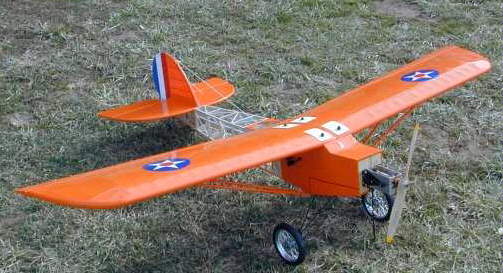
1_ Blue Max ( Global ARF ) 68" about 700 squares, geared Astro Cobalt 40, 21 - 2400 cells, Master Airscrew 12x8
electric prop. Flies good at 8 lb. but airframe is "draggy" and sucks those Sanyos dry in 4 to 4.5 minutes.
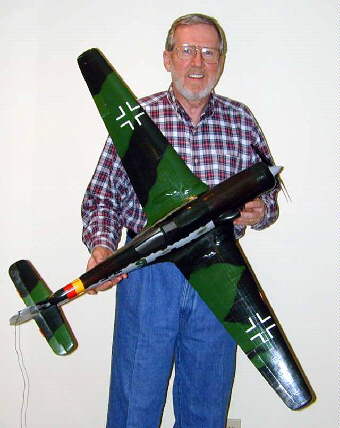
2_ Ta152Hi ( Parkflyers.com ARF ) Anything but a parkflyer ! Can you say pylon racer. 49" about 250 squares,
Aveox 1015/1.5Y direct drive on 8 - 2400 cells, Graupner Cam 8x4.5 folder. A handful !
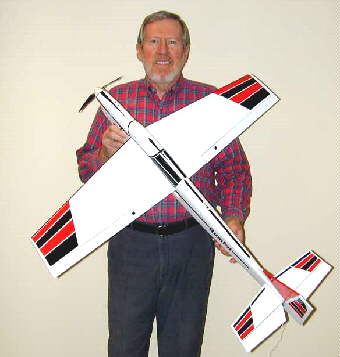
3_ Rumfal ( Dymond - JR - ARF ) 39" about 300 squares, Kyosho Magnetic Mayhem direct drive, 8 - 2400 cells,
Graupner 7.5x4 folder. Great flyer....axial rolls ( like I hoped my Electrostreak would be .....but wasn't until I installed a Astro
Cobalt 15 and 10 cells ).
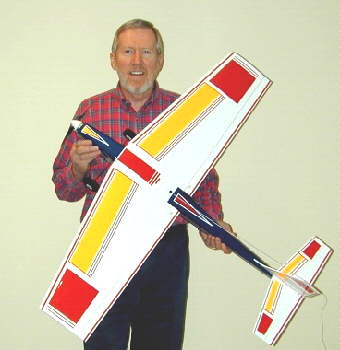
4_ Electrostreak with Astro Cobalt 15 direct drive, 10 - 2400's, and Graupner 8x4.5 Cam folder. Flies great but has no glide
when the power is gone.
Return to "What's In This Issue?"
Astro Flight Viking
From: John Zook email:johnzook@voyager.net
Hi Ken and to all in the club!
I just had my first flight this morning with the Astro Viking. The plane ROGed in
about 30 feet. The climb rate is great, and it can also thermal as I found , making a 15 minute flight. I could have remained aloft
longer but I was both excited and relieved the plane flew so well.
Specs:
Astro Viking; scratch built from plans...63" wingspan, and an all up weight of 3 lbs.
motor: Magnetic Mayhem through Leisure 2.5:1 gearbox, APC electric 10X7 prop. 8 Sanyo 2400 cells. Castle
Pegasus 35 speed control. Hitec 555 receiver and 2 HS-81 servos. This combination flew much better than I hoped. Next time I
will see how long I can keep it in the air.
Till then, fly cleanly, fly quietly.
Return to "What's In This Issue?"
Propstoppers Philadelphia Electric Fun Fly
From: Dave Harding email:davejean1@home.com
The Propstoppers of Delaware County, Pennsylvania, just
southwest of Philadelphia will hold their annual Electric Fun Fly on Saturday August 25th,
rain date Sunday 26th.
As in prior years, this is just a fun day in the beautiful
Pennsylvania countryside. This year we plan to hold an Elexaco contest for all models, Old
Timers and new also Zagi Combat.
We have not decided which of our two fields to use so check
on our web page before you make final arrangements however, both are pleasant places to fly
and they are only about three miles apart.
www.geocities.com/propstoppers_rc
The Burlington County RC Club of New Jersey have decided not
to hold their event this year so why not join the Propstoppers instead.
Return to "What's In This Issue?"
SR Batteries Cutie Released!
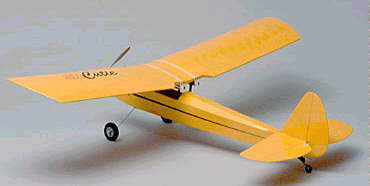
At last, the cute Cutie has been released by SR Batteries. Following the excellent
X-250 kit, this should be a winner as well. For more info, visit the SR Batteries’ site at
www.srbatteries.com or phone: 631.286.0079 This should be a great, relaxing flier,
as well as a good, easy to build trainer.
Return to "What's In This Issue?"
To Reach Ken Myers, you can land mail to the address at the top of the page. My E-mail
address is:
KMyersEFO@aol.com
EFO WEBsite: http://members.aol.com/KMyersEFO/
|
|













